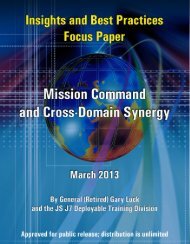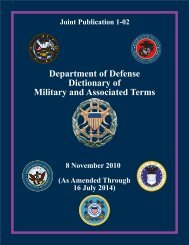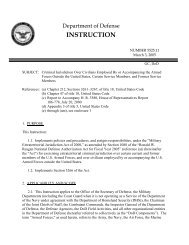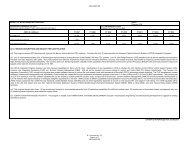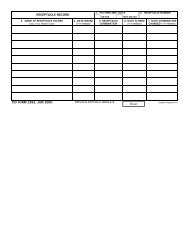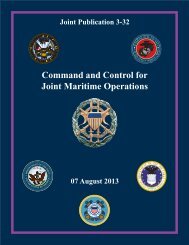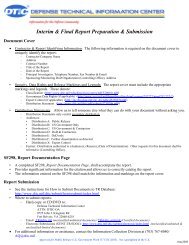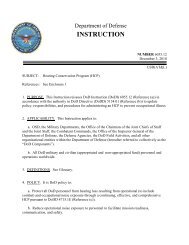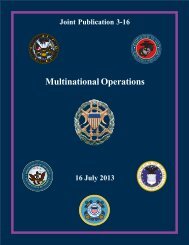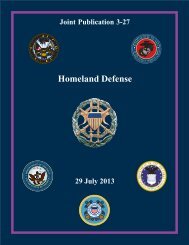JP 1, Doctrine for the Armed Forces of the United States - Defense ...
JP 1, Doctrine for the Armed Forces of the United States - Defense ...
JP 1, Doctrine for the Armed Forces of the United States - Defense ...
Create successful ePaper yourself
Turn your PDF publications into a flip-book with our unique Google optimized e-Paper software.
<strong>Doctrine</strong> Governing Unified Direction <strong>of</strong> <strong>Armed</strong> <strong>Forces</strong><br />
coordinating executive branch ef<strong>for</strong>ts to detect, prepare <strong>for</strong>, prevent, protect against, respond<br />
to, and recover from terrorist attacks within <strong>the</strong> US.<br />
(b) In domestic situations, US law and policy limit <strong>the</strong> scope and nature <strong>of</strong><br />
military actions. SecDef retains <strong>the</strong> authority to approve use <strong>of</strong> DOD resources <strong>for</strong><br />
assistance to civil authorities. For DSCA operations within <strong>the</strong> US, <strong>the</strong> Joint Staff Joint<br />
Director <strong>of</strong> Military Support (JDOMS) validates requests <strong>for</strong> assistance, determines what<br />
DOD capabilities are available to fulfill <strong>the</strong> request, and coordinates SecDef approval to use<br />
DOD <strong>for</strong>ces. JDOMS will normally allocate Title 10, USC, <strong>for</strong>ces to <strong>United</strong> <strong>States</strong> Nor<strong>the</strong>rn<br />
Command (USNORTHCOM) <strong>for</strong> operations approved by SecDef. The National Guard has<br />
unique roles in domestic operations. The National Guard in ei<strong>the</strong>r state active duty or Title<br />
32, USC, status (not in federal service) is likely to be <strong>the</strong> first military <strong>for</strong>ce to provide<br />
support <strong>for</strong> an incident.<br />
(c) Per <strong>the</strong> Posse Comitatus Act and DOD regulations, <strong>the</strong> US is generally<br />
prohibited from employing Title 10, USC, DOD <strong>for</strong>ces to provide direct military<br />
involvement to en<strong>for</strong>ce <strong>the</strong> law <strong>of</strong> <strong>the</strong> US unless expressly authorized by <strong>the</strong> Constitution or<br />
Congress. For example, <strong>the</strong> President, as Commander in Chief under <strong>the</strong> Insurrection Act,<br />
may use <strong>the</strong> military in cases <strong>of</strong> civil disturbance and to protect USG functions and property.<br />
It is important to note that use <strong>of</strong> military <strong>for</strong>ces in <strong>the</strong> defense <strong>of</strong> <strong>the</strong> US is not support to<br />
civilian law en<strong>for</strong>cement and is not subject to <strong>the</strong> prohibitions <strong>of</strong> <strong>the</strong> Posse Comitatus Act.<br />
(d) In addition to coordinating with USG departments and agencies, o<strong>the</strong>r<br />
domestic participants may be involved, to include state, local, and/or tribal government<br />
organizations as well as <strong>the</strong> types <strong>of</strong> NGOs and IGOs that operate domestically and/or<br />
internationally.<br />
For more in<strong>for</strong>mation on HS, HD, DSCA, and associated interagency coordination activities<br />
in support <strong>of</strong> <strong>the</strong>se missions, see <strong>the</strong> National Strategy <strong>for</strong> Homeland Security, National<br />
Response Framework, DOD Strategy <strong>for</strong> Homeland <strong>Defense</strong> and Civil Support, <strong>JP</strong> 3-27,<br />
Homeland <strong>Defense</strong>, and <strong>JP</strong> 3-28, Civil Support.<br />
(4) Command Relationships<br />
(a) Command relationships preserve <strong>the</strong> primacy <strong>of</strong> civil authorities in <strong>the</strong>ir<br />
spheres <strong>of</strong> responsibility while facilitating <strong>the</strong> full utilization <strong>of</strong> military <strong>for</strong>ces as permitted<br />
by <strong>the</strong> Constitution, law, and directives <strong>of</strong> <strong>the</strong> President. Military commands provide<br />
assistance in consonance with <strong>the</strong>se directives <strong>for</strong> activities conducted under <strong>the</strong> control <strong>of</strong><br />
civil authorities.<br />
(b) The relationship between NGOs, IGOs, and US military elements may be<br />
viewed as an associate or partnership relationship. These civilian organizations do not<br />
operate in military or governmental hierarchies and <strong>the</strong>re<strong>for</strong>e do not have <strong>for</strong>mal supporting<br />
or supported relationships with US military <strong>for</strong>ces. However, an MOA or memorandum <strong>of</strong><br />
understanding can outline agreed to relationships.<br />
(5) Organizing <strong>for</strong> Interagency Coordination<br />
II-17



